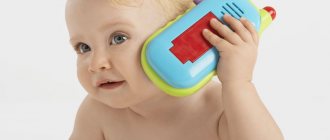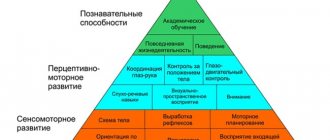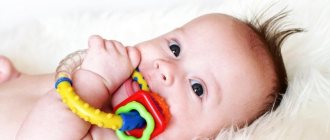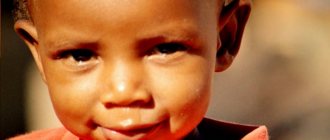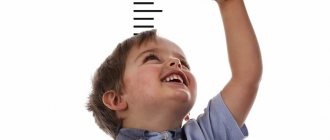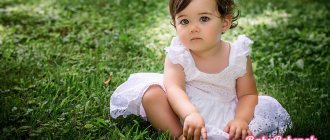Development of a child up to one year old by month in pictures for children
Vision develops only when it is engaged.
Babies spend their first weeks and months of life learning to see the world around them. During this period, such skills as gaze fixation, friendly movements of both eyes, depth recognition, development of visual-tactile reactions, and spatial perception develop. Initially, the more visual information your baby receives, the more actively his brain develops. Therefore, a child whose environment is visually enriched is more calm and attentive during wakefulness than a child deprived of stimulation. The first and most important visual objects that have a stimulating effect on the development of a baby’s vision from birth are the faces of mom and dad. Therefore, look at your child as often as possible, communicate with him, smile. In second place are contrasting black and white structured images that the baby can “examine.” Looking at how my Main Reader liked to look at the autumn black tree branches against the light sky, I always regretted that we didn’t have a panda, a zebra, or at least a Dalmatian at home.
The period from birth to six months is extremely important for the development of a child’s vision, since it is during this time that the eyeball, the pathways leading from it to the brain, and those parts of the brain that are responsible for receiving and processing visual information are most quickly and intensively formed. Psychophysiologists consider this age period as critical for the formation of the visual system. It is the first six months of a child’s life that is the most sensitive to external stimulation time for the development of the visual system, optimal for conducting classes. As a result of such exercises, visual functions improve: light perception, visual acuity, color perception, contrast sensitivity, field of view. Classes can be carried out on a changing table, in a crib, on a bed, etc., but it is better that the light source is behind the baby’s head, i.e. It is more convenient to place the child’s head towards the window.
In the first months of life, it is important to develop two visual skills: to fix and examine an object, and to trace it. Here are a number of exercises with pictures for fixation and tracing that will help your baby ( F
– fixation,
P
– tracking):
0-1 month:
At birth, your baby's field of vision is limited - 30 degrees to the left and right of him, 10 degrees above and below, at a distance of no more than 90 cm from the body. His vision is 10 to 30 percent less sharp than yours, making it harder for him to see fine lines. He sees them as a blurry gray mass. In addition, newborns benefit from contrasting black and white patterns more than colors because during this period their rods (cells in the retina that are sensitive to low light and only distinguish between black and white) work better than their cones (cells that see colors). in bright light). In the first month of life, babies prefer simple geometric shapes, checks, stripes, dots, straight and broken lines over curved and wavy ones. Already at 10 days, the baby can keep a moving object in his field of vision (stepped addition), and at 20 days he can focus his gaze on a stationary object and on the face of an adult talking to him. By the end of the month, he tries to follow a slowly moving black and white object or the face of an adult at a distance of 20-30 cm. He notices objects and examines them for a short time.
F:
Show and also attach sheets of paper with black and white contrasting patterns to the walls of the crib. Change them as difficulty increases. This will help the baby focus his eyes. Black and white photographs of mom and dad will also work.
It is useful to make a black and white mobile for your child. You can hang it on a hanger, having previously made notches on it for threads, or on crossed pencils. It’s even easier to buy a ready-made rotating mobile in the store and temporarily change the hanging toys to black and white ones.
P:
Show your baby a picture at a distance of about 30 cm from the eyes. The child will notice her and fix her gaze on her. Slowly move the picture to the right, then to the left (horizontal tracking). In the future, bring the picture closer to the baby and remove it again (20cm - 1 meter - vertical tracking).
1 – 3 months:
The baby can clearly focus his vision on objects at a distance of about 30 cm and usually begins to smile and examine the details of his face and patterns. He is especially attracted to images of circles, rings, spots. In addition, he will look more closely at the outer edges of the drawings than at the middle. The child is already following the object when he is taken a little to the side. Within 1-2 minutes he can visually concentrate on a stationary object. By the end of the third month of life, he turns his gaze to an object that appears in the field of vision: from the side, from above, from below. He follows an object moving in all directions at a distance of 20-80 cm. He waits for the appearance of an object that has disappeared from his field of vision.
